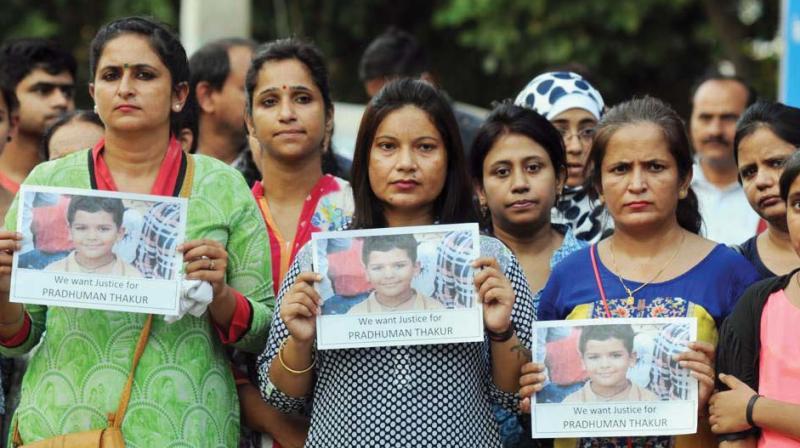By invitation: When kids in school are preyed on...
Bullying should be dealt with more stringently both by teachers and parents.

Episodes of mass shooting by teenagers in schools, and violent outbursts and other deviant behaviour among the young, were somehow more common in the West. We always prided ourselves in being a culturally strong country with a well-anchored value system. But not anymore. Now cases of young people being involved in abduction, sexual assault, theft, murder, vandalism, reckless driving, and financial fraud are on the rise in our country too. What is even more worrying is the complete absence of guilt, regret or remorse among these youth. Only recently, five young men were convicted in Delhi for beating up an Air Force Officer, who overtook their car. And a 20 -year -old in the capital killed someone over something as trivial as who should get a paratha first.
The most recent incident is the alleged involvement of a Class XI Ryan International School student in the murder of seven-year-old Pradyuman Thakur, who was found dead in the school toilet on September 7 this year. While the state police initially arrested the school bus conductor for the child’s murder, the CBI, which took over the investigation, has pointed fingers at the Class XI student, claiming he did the crime only to postpone a parent-teacher meeting and examinations. The boy has reportedly confessed to the murder after he was picked up by the law men.
This raises a series of questions. Is there a pattern in these crimes or do a set of background factors contribute to such behaviour among the young? Who or what is responsible for these acts? What could be the psychological impact of wrongful accusation? And what can we do to prevent such crimes?
I attempt to find answers to these questions from my perspective as a parent, teacher and psychologist. The old cliché is that “the best predictor of future behaviour is past behaviour.” A violent history or background is a major red flag that signals distress and is a warning sign of similar future outbursts. Having said that, there are also instances of violent acts by people, who have never demonstrated truly violent behaviour before and were described as mild mannered and as being “nice to everyone.” How does one explain this? Surely people don’t just wake up one morning and decide to stab somebody.
Movies and fiction have given us enough fodder to make each one us an Agatha Christie looking for psychological clues and angles to a crime and the criminal. In the Ryan International School episode, there are classmates, who have described the accused as a “vulgar character,” “rude and heavier than normal boys his age.” He reportedly showed a tendency to slap people over trivial issues and was neither good at studies nor sport. It has also been reported that he was addicted to pornography and was seeking psychiatric assistance for the last one year.
Finding a pattern of causes is natural and is perhaps indicative of an underlying disturbance. However, often there is more and it is important to understand what this is rather than simply generalise and allow things to go on as before. Psychologists often talk about two major groups of violent perpetrators : the chronic offenders, who have a history of violence and who have a childhood characterised by neglect and deprivation. They are typically average or below average in intelligence and display anti-social and aggressive behaviour.
The other type is the ‘erupter’ who does not share any of the typical features of the chronic offender, but is socially awkward and fails to attach to others due to psychosis, autism or other neurological or mental health disorders. They may appear sociable, but they are primed to explode. Stressors may be perceived as a significant injury to their ego or identity. The deeper the hurt, the weaker will seem the support system, and the greater will be the outburst.
Particularly in the Indian cultural context the other contributory factors that aggravate violent behaviour are poverty, unfair parental expectations based on flawed success parameters, a school system that is regimental rather than progressive, and a sense of self -worth almost always linked to academic performance , affluence and exaggerated class differences.
Given the dynamics of human behaviour, all these are still just predictors and not conclusive facts. But it is important to evolve a mechanism to screen and identify who is at risk by using some objective measures of assessment. We can prevent attacks and save lives by addressing specific risk factors. We have to be more proactive rather than reactive in doing this.
We must as a society remove the stigma attached to mental health. For every violent outburst, there are probably countless others that can be averted by an insightful school guidance counsellor or other barefoot counsellors in the community. Both perpetrators and innocent victims need help before it is too late. There is a dire need to make these services more accessible and affordable. Bullying should be dealt with more stringently both by teachers and parents. Life skills like anger management, problem solving and interpersonal relationships need to be integrated into the curriculum from an early age.
At the end of the day it is the collective responsibility of the parents, teachers, peers and the society at large to strengthen the moral fibre of the young through value- based education that enables them to make a life rather than merely make a living.

